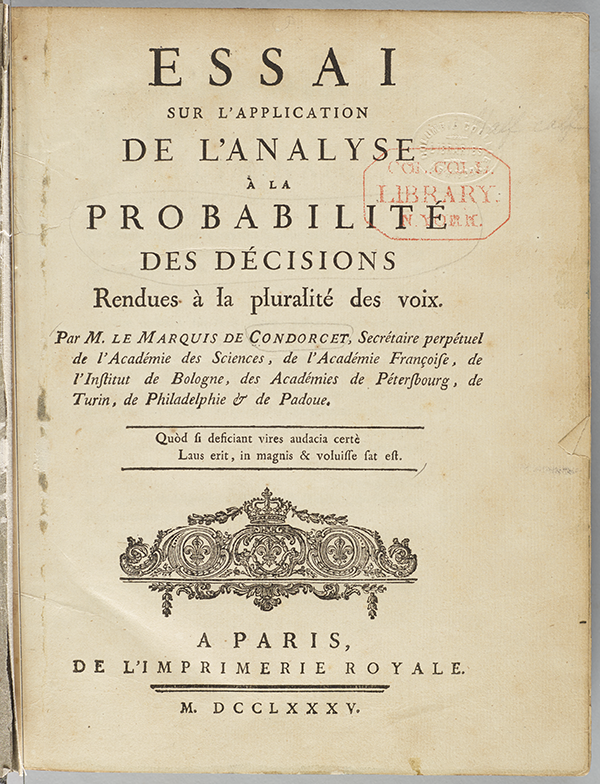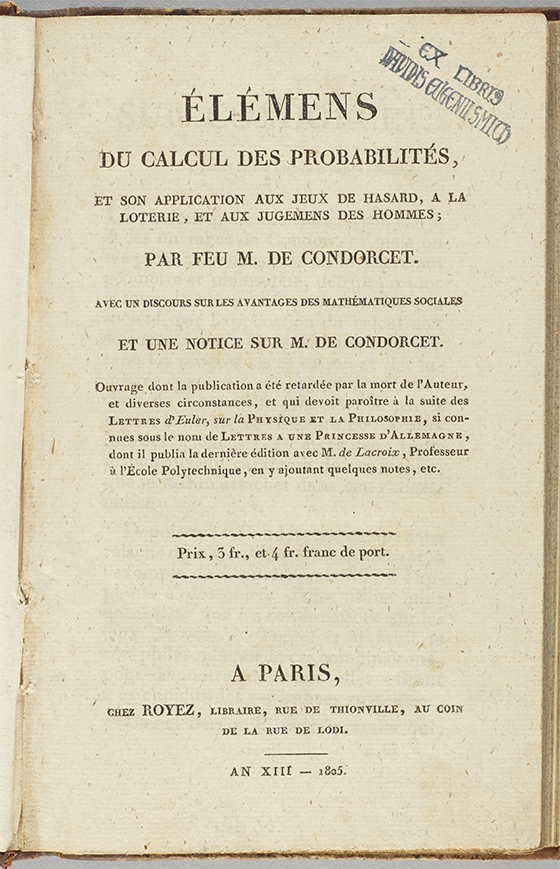- About MAA
- Membership
- MAA Publications
- Periodicals
- Blogs
- MAA Book Series
- MAA Press (an imprint of the AMS)
- MAA Notes
- MAA Reviews
- Mathematical Communication
- Information for Libraries
- Author Resources
- Advertise with MAA
- Meetings
- Competitions
- Programs
- Communities
- MAA Sections
- SIGMAA
- MAA Connect
- Students
- MAA Awards
- Awards Booklets
- Writing Awards
- Teaching Awards
- Service Awards
- Research Awards
- Lecture Awards
- Putnam Competition Individual and Team Winners
- D. E. Shaw Group AMC 8 Awards & Certificates
- Maryam Mirzakhani AMC 10 A Awards & Certificates
- Two Sigma AMC 10 B Awards & Certificates
- Jane Street AMC 12 A Awards & Certificates
- Akamai AMC 12 B Awards & Certificates
- High School Teachers
- News
You are here
Mathematical Treasures - Condorcet on the Application of Probability to Voting
Essai sur L’Application de L’Analyse a la Probabilité des Décisions Rendues à la Pluralité des Voix (1785) was a pioneering work in the application of probability theory to the understanding of social issues. Its author was a French philosopher, mathematician and political scientist, Marie Jean Nicolas de Carcilat Condorcet (1743–1794). A marquis, he was more commonly referred to simply as Nicolas de Condorcet. In mathematics, Condorcet published several noteworthy works on integral calculus, but today he is better remembered for his contributions to the field now known as “voting theory.”

As suggested by the full title of his 1785 Essai, which translates in English to Essay on the Application of the Analysis of Probabilities to Decisions Rendered by a Plurality of Votes, Condorcet’s goal in this 495-page text was to apply techniques from the mathematical theory of probability to questions related to the societal problem of reaching collective decisions. Urken [2008, p. 1] has described it as “one of the most frequently cited, least-read and poorly-understood works in voting theory.”
The book begins with a 191-page “Discours Préliminaire” (or preface) in which Condorcet explained the motivation behind and the general layout of his Essai. In keeping with his Enlightenment commitments to rationality and social justice, he described his work as an investigation into the problem of providing individuals within a society with sufficient assurance that the decisions rendered by groups of individuals (e.g., trial juries or voters in an election) are, in fact, correct. In the case of a jury trial, the notion of a “correct decision” is clear: guilty individuals should be judged to be guilty, while the innocent should go free. In the case of voters in an election, the notion of a “correct decision” was understood by Condorcet as the selection of the candidate (or law) that would best serve the common good. Voters were thus assumed to be motivated not solely by their own personal preferences, but also by their honest appraisal of who (or what) would be in the best interest of the general welfare of the society-at-large.These individual appraisals (both among jurors and voters) could nevertheless be mistaken. In the Essai, Condorcet used probability theory as a tool for analyzing collective decision-making procedures under various conditions (e.g., the number of jurors or voters, the competence of the individual decision makers), with the goal of maximizing the likelihood of arriving at correct final outcome.
In his “Discours Préliminaire,” Condorcet also explained the basic principles of probability, for the benefit of readers who were not themselves mathematicians. The Essai itself consists of 304 pages, divided into five parts. Parts I–IV contain the details of Condorcet’s analysis of the probabilities involved in various collective decision making procedures. In Part V, he applied the principles developed in those earlier sections to particular examples. One of the best-known of these examples today is that of an election involving three or more candidates. Condorcet’s treatment of this example included a critique of the method of plurality voting (in which the candidate with the highest number of first-place votes wins the election), on the basis that a candidate who is preferred one-on-one to all other candidates may not have the most first-place votes. As an alternative, he proposed the method known today as “Pairwise Comparisons,” in which the outcomes of all possible one-on-one comparisons of pairs of candidates are used to select the election winner. A specific instance in which “Condorcet’s Paradox” occurs is also presented: although candidate A is preferred overall to candidate C, and candidate C is preferred overall to candidate B, transitivity fails and candidate B is preferred overall to candidate A. Condorcet himself did not view this outcome as paradoxical, yet for such cases he proposed an algorithm which he claimed (without proof) would produce the winner with the highest probability of being the correct choice.

Condorcet’s Élémens du Calcul des Probablities et Son Application aux Jeux de Hasard, à la Loterie, et aux Jugemens des Hommes, another book on the applications of probability, was published posthumously in 1805.

The first and third images on this page are presented through the courtesy of the Columbia University Libraries, from its George Arthur Plimpton Collection. The second image, an excerpt from page 68 of the copy of Condorcet’s Essai owned by the Fisher Library at the University of Toronto, is presented courtesy of the Internet Archive.
References
Urken, Arnold B. Grokking Condorcet’s 1785 Essai. Electronic Journal for History of Probability and Statistics. Vol. 4, no. 1, June 2008.
Frank J. Swetz (The Pennsylvania State University) and Janet Heine Barnett (Colorado State University - Pueblo), "Mathematical Treasures - Condorcet on the Application of Probability to Voting," Convergence (June 2020)




